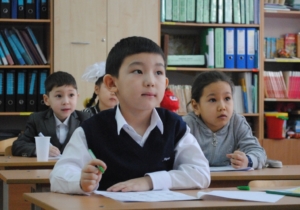Education in Kazakhstan
 Kazakhstan‘s rapidly growing economy has laid the groundwork for the introduction of several economic, social, and political reforms that have improved the quality of life and spurred the development of a strengthened system of education in Kazakhstan.
Kazakhstan‘s rapidly growing economy has laid the groundwork for the introduction of several economic, social, and political reforms that have improved the quality of life and spurred the development of a strengthened system of education in Kazakhstan.
Under Article 30 of the 1995 Constitution, Kazakh citizens have the right to free secondary education as well as free higher education in state institutions on a competitive basis. The state has implemented several measures of education reform in recent years. Kazakhstan adopted an updated version of the Law on Education in 2007, with components focused on strengthening national regulation of education and improving upon the nation’s existing education system. One particularly significant component of the new law increases the years of compulsory education to 12. The law also improves upon existing vocational training structures and creates a three-stage model of higher graduate and post-graduate education.
Reform targeting education spending has also been introduced, with total expenditure on education jumping from 2.5 percent to 3 percent in 2006. This commendable improvement nevertheless remains one of the lowest figures of education spending in the CEE/CIS region. The Kazakh government has also indicated its commitment to establishing more educational institutions— it opened 80 new schools in 2008 and is scheduled to establish 245 more within the next five years.
Access to primary and secondary schools across different genders, regions, and income levels is impressively high in Kazakhstan. The total student enrollment rate within primary schools was 91 percent in 2005, with an attendance rate of 98 percent. These figures remain similarly high in secondary schools, with 2005 figures of 92 percent for net enrollment and 95 percent for net attendance. Kazakhstan boasts the lowest number of children lacking access to education levels than any other country in the region. However, Kazakhs benefit far less from access to early childhood education—a mere 33 percent of Kazakh children attend preschool, a disadvantage that leaves many children without regular health checks and immunizations while also making the task of identifying learning disabilities far more difficult.
Access to schooling for children with special learning needs continues to pose a daunting problem to education in Kazakhstan. Disabled children have yet to be fully incorporated into the public education system; a dire lack of resources coupled with few trained professionals in this particular field prevents such needs from being adequately addressed.
Girls enjoy equal access to primary and secondary schooling as do their male counterparts, with a disparity in attendance ratios comprising less than one percentage point. Similar parity applies to children of different regions and income groups, with only a small gap prevailing between students from the wealthiest and poorest income groups upon reaching secondary school.
Kazakhstan has succeeded in keeping a relatively low student-teacher ratio of about 11-to-1. However, several important problems relating to quality continue to pervade the structure of education in Kazakhstan. The country currently lacks a viable method with which to measure learning outcomes, an insufficient supply of teachers remains grossly overworked and underpaid, and the large shortage of schools serves as a persistent disadvantage. The national curriculum and instructional materials, largely remnants of the Soviet era, also need updating along with a reliable set of uniform standards, which must be developed in order to ensure accountability and equality from one school district to another.
– Shenel Ozisik
Sources: UNICEF, IBE
Photo: Flickr
